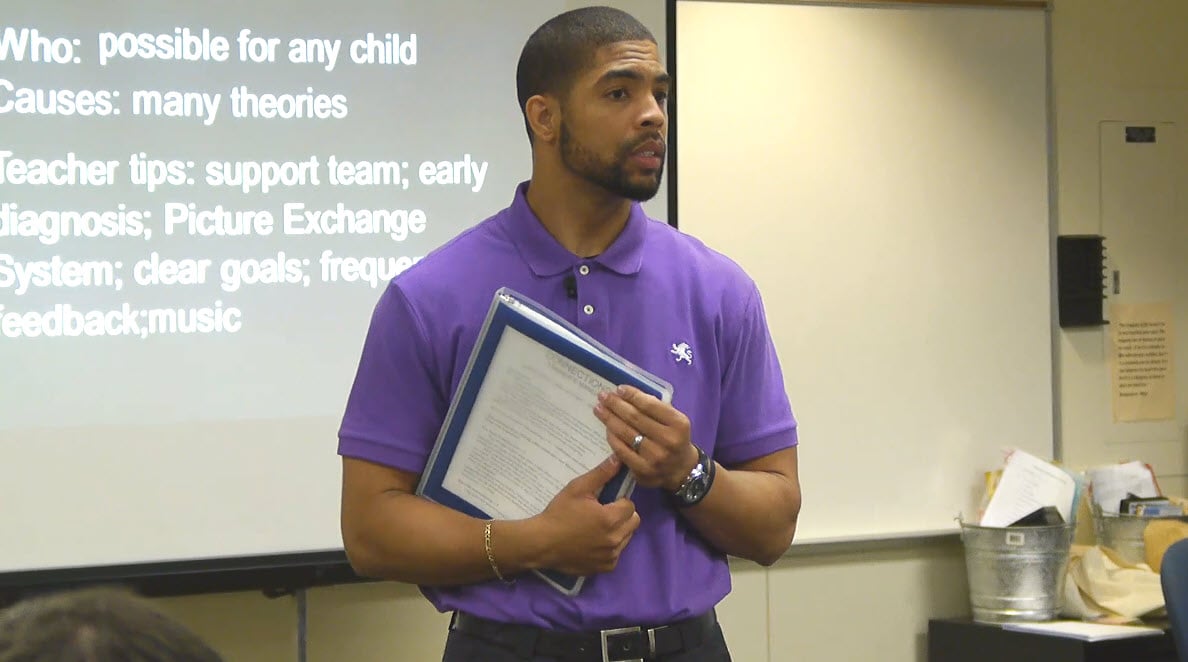



Getting your online elementary teacher certification can feel like an overwhelming process. After all, you likely have a lot on your plate already, whether it’s a job, family life or other obligations.
The good news is, there is a path to certification for you no matter where you are in life, and that path works around your schedule.
Yet obtaining an online elementary teacher certification is not just a credential, it’s a gateway to shaping young minds and inspiring future generations. Let’s dive into the steps to get you on your way to becoming an online elementary teacher extraordinaire:
Enroll in a teacher certification program
Fulfill your training requirements
Pass your exams
Submit your teaching license application
Alternative teacher certification programs are a great way to get your elementary teacher certification if you have:
Choosing a path that provides courses online or partially online, in particular, offers many benefits, from flexible scheduling to better course availability.
In the state of Texas, alternative teacher certification programs that offer online courses as part of their curriculum are especially popular, with 49% of all new teachers choosing this path to certification. Another 34% are prepared through undergraduate secondary or elementary education programs, whether classes are held on college campuses or through a university’s online program.
If you are not already enrolled in a college teacher education program to earn your undergraduate degree, you’re likely considering the same path as nearly half of all new teachers choose - an alternative teacher certification program.
If your new career goal is to teach and you have already earned your bachelor’s degree, an alternative teacher certification program can get you on the path to achieving your dreams. This is true as well for those who have earned an associate’s degree, have career experience or a combination of both.
 Bachelor’s Degree
Bachelor’s DegreeIf you have a bachelor’s degree, to qualify for an alternative teacher certification program, your degree must be from an accredited institution of higher learning. According to the Texas Education Agency (TEA), you must also:
If you’re currently completing your last semester toward a bachelor’s degree, you can still qualify for enrollment in an alternative teacher certification program. However, you must provide a copy of your final semester schedule of classes letter from an academic adviser or registrar indicating you are eligible for graduation.
If you’re graduating from a university outside the United States or U.S. Territories, you must also provide foreign transcripts that have been equivocated by a recognized transcript evaluation service and proof of oral English language proficiency by passing the oral proficiency portion of the TOEFL.
If you don’t have a bachelor’s degree, you can still qualify for an alternative teacher certification program as well.
If you have an associate’s degree from an accredited institution, you must have:
If you don’t have a degree, you must have five years of full-time wage-earning experience within the past 10 years in the field to be taught.
Now that you know whether you qualify for an online teacher certification program, it’s time to choose what program best meets your needs.
Many programs are strictly online. Other programs include a hybrid of both online courses and in-person training, offering the best of both worlds.
One of the greatest benefits of online teacher certification programs is that they provide a great deal of flexibility. This allows you to complete your course requirements around your schedule. Other benefits include:
Alternative teacher certification programs that offer a hybrid of online and in-person training provide the benefits above, as well as additional perks that can have a significant impact on a student’s experience. For example, in-person training allows you to develop professional relationships and connections with faculty that you may otherwise miss when only connecting online.
Other benefits that give these types of programs an edge include:
The best alternative teacher certification programs will also offer test preparation help for the TExES as a standard part of the training program.
Once you have chosen and enrolled in an alternative teacher certification program and passed all relevant content tests, the next step is to fulfill your training requirements toward certification.
A portion of your training will consist of courses (online, in-person or a combination of both depending on the program you choose) as well as field experience.
In Texas, you must complete:
Your preparation program will also work with you to develop a plan that completes these requirements, as well as assist you with securing a teaching assignment at the grade level and in the specialty area, such as special education, of your target certificate.

An important component of the online elementary teacher certification process is passing the required Texas exams.
One of the most important professional certification examinations you must take is a content exam. The content exam you take will depend on the subject area or grade level you wish to teach.
To become an elementary school teacher, you’ll likely take a content exam like “Core Subjects with Science of Teaching Reading (EC-Grade 6). However, you may want to broaden your appeal and knowledge as an educator and earn a multiple-subject teaching credential.
While a single-subject teaching credential focuses on becoming certified to teach in one area, a multiple-subject teaching credential allows you to have more options when it comes to what and who you teach. For example, you may want to consider a specialty like “American Sign Language” or even “Special Education” since you’ll likely work with a wide range of students and abilities in your classroom. Broadening your content knowledge and appeal as a teacher can also make you more marketable to school districts when it comes time to look for your ideal teaching position.
Our article, List of Texas Teacher Certification Tests: What You Must Take To Teach, provides a comprehensive list of the content exams available to you to take in Texas.
Important note about timing: At ECAP, we ask our interns to immediately take a practice content test to establish a baseline of where your knowledge base is at. This way, each intern will have a good understanding of their current knowledge level in each subject area and know which areas they need further training in.
Then, we strongly encourage each intern to take 40 hours of online training before they take the actual exam. While the content test currently has a passing score of 240, we instruct our candidates to aim for a score of 270. Once you score a 270, ECAP will give you permission to take your content exams. Hitting a score of 270 gives you a buffer zone for your final content exam test. Just hitting the 240 score leaves you no room for error.
It is best to work with your program to ensure you are taking the right content exams and so you know how to prepare for them. Which content tests you take will depend on which subject areas and grades you wish to teach.
In addition to your content exams, you may also need to take the Science of Teaching Reading. This teaching reading exam is required if you plan to get certified in one of the following areas:
Early Childhood: EC - Grade 3
Core Subjects with Science of Teaching Reading: Early Childhood - Grade 6 or Grades 4-8
English Language Arts and Reading with Science of Teaching Reading - Grades 4-8
English Language Arts and Reading/Social Studies with Science of Teaching Reading - Grades 4-8
This test focuses on standards that address the practice of teaching early reading. This includes areas like proper teaching techniques, strategies, theories of learning, understanding students and their needs, and incorporating the backgrounds and interests of students into teaching methods.
The exam also covers knowledge of Reading Development Components, including:
Oral language development
Print awareness and alphabet knowledge
Phonological and phonemic awareness
Phonics (decoding and encoding)
Reading fluency
Vocabulary development
Syllabication and morphemic analysis
Comprehension of literary text
Comprehension of informational text
Beginning strategies and reading comprehension skills
A Reading Pedagogy component will focus on having test takers demonstrate an understanding of the principles of reading instruction and assessment. Questions will focus on topics such as measuring student progress in early reading development, creating developmentally appropriate instruction and using background information to create more engagement among students.
Finally, you must take the PPR as well. The PPR, or Texas Examinations of Educator Standards Pedagogy and Professional Responsibilities, “is designed to assess whether a test taker has the requisite knowledge and skills that an entry-level educator in this field in Texas public schools must possess,” according to the TEA.
The Texas State Board of Education has weighed removing the PPR from the state’s list of requirements and replacing it with another exam. In fact, the state recently tried to replace the PPR with a new requirement called the edTPA, but the initiative failed after it was determined the new requirement wouldn’t help solve the state’s teacher shortage.
No one is certain what future testing requirements are in the pipeline, so if you’re considering earning your teacher certification, NOW is the time to act while current certification requirements remain in place. If you wait until as soon as the 2023-24 or 2024-25 school year to begin your program, you may face more difficult barriers to earning certification.
Once you have completed your training and examinations that are needed to become an elementary school teacher in Texas, you must now apply for your teaching license.
To apply, a Texas Education Agency Login (TEAL) account is required. This account will give you access to your profile located in the Educator Certification Online System (ECOS). Make sure you use the first and last name that matches your Texas driver’s license or state identification.
You’ll also need to complete a fingerprinting process as part of a national criminal background check. Applicants must submit fingerprints electronically by using an approved vendor.
Even after you earn your certification, keep note of any professional development classes you must take to renew your certificate. You must renew your standard Texas teacher certification every five years.
Renewal requirements include:
Success at completing 150 continuing professional education (CPE) hours (200 if you hold an administrative or student services certificate)
Providing documentation that you have completed each CPE activity or required course
Completing a renewal application
Continuing education material should be related to your certification being renewed or the services that you provide.
With any path toward certification, there are requirements put into place to ensure all new teachers are properly qualified, trained and vetted before they are allowed to enroll in a program, step foot into a classroom or complete the certification process.
Working with your alternative teacher certification program to complete each of the above steps will ensure that you not only meet all requirements associated with obtaining your teaching certificate, but do so in the most efficient way so you can complete your journey to becoming an elementary school teacher.
Topics: Becoming A Teacher
Micah is the Director of Curriculum & Technology. He holds a Bachelor of Arts in British Literature, from the University of North Texas and a Master of Arts in Teaching, from Louisiana College. In his previous career, Micah served for 14 years as a banker and bank manager. For the majority of this period, Micah managed the Downtown Fort Worth location of Frost Bank. In 2005, Micah finally surrendered to his true calling to be an educator. After a brief, but fulfilling term teaching high school English at Flower Mound High School in Lewisville ISD, Micah went to work for the family business, training teachers.
7166 Baker Blvd., Suite B · Richland Hills, Texas 76118
Phone 817-284-7731 | Fax 817-284-3396
Login | Make Payment | ECAP Handbook | Privacy Policy | Pricing
Your Comments